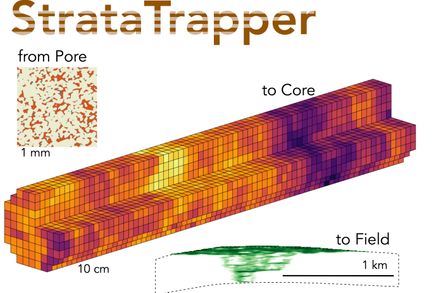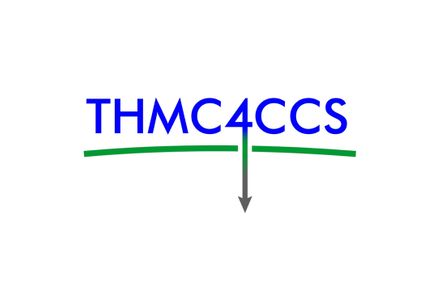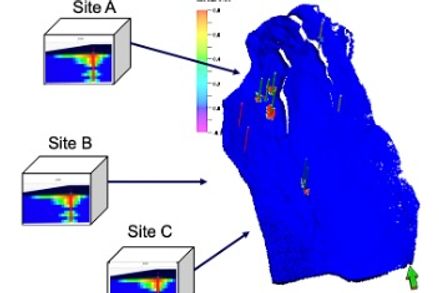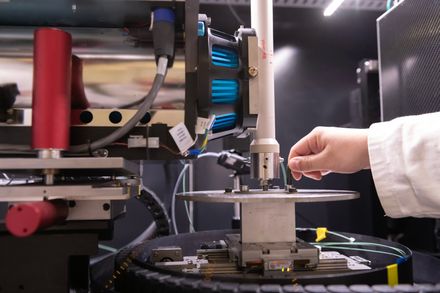We investigate the physics, chemistry, and techno-economics of CO2 storage underground
Our research includes exploring fundamental pore scale fluid dynamics, developing digital rocks analysis techniques, increasing the accuracy of field scale reservoir simulation, and evaluating the feasibility of scaling up CO2 storage to climate relevant scales.
Our Research Projects

StrataTrapper Advanced Modelling of CO2 Migration and Trapping

THMC4CCS: ThorougH experiMental and numerical investigation of Coupled processes for geologiC Carbon Storage
Results
- Showing results for:
- Reset all filters
Search results
-
Conference paperKrevor S, Boon M, Lai P, et al., 2017,
Characterising pore scale mineral heterogeneity and solute transport to model reactive transport for CO2 storage
, 253rd National Meeting of the American-Chemical-Society (ACS) on Advanced Materials, Technologies, Systems, and Processes, Publisher: AMER CHEMICAL SOC, ISSN: 0065-7727 -
Journal articleKolster C, Mechleri E, Krevor S, et al., 2017,
The role of CO<inf>2</inf> purification and transport networks in carbon capture and storage cost reduction
, International Journal of Greenhouse Gas Control, Vol: 58, Pages: 127-141, ISSN: 1750-5836A number of Carbon Capture and Storage projects (CCS) are under way around the world, but the technology's high capital and operational costs act as a disincentive to large-scale deployment. In the case of both oxy-combustion and post-combustion CO 2 capture, the CO 2 compression and purification units (CO 2 CPU) are vital, but costly, process elements needed to bring the raw CO 2 product to a quality that is adequate for transport and storage. Four variants of the CO 2 CPU were modelled in Aspen HYSYS each of which provide different CO 2 product purities at different capital and operating costs. For each unit, a price of CO 2 is calculated by assuming that it is an independent entity in which to invest and the internal rate of return (IRR) must be greater or equal to the minimum rate of return on investment. In this study, we test the hypothesis that, owing to the fact that CO 2 will likely be transported in multi-source networks, not all CO 2 streams will need to be of high purity, and that it may be possible to combine several sources of varying purity to obtain an end-product that is suitable for storage. We find that, when considering study generated costs for an example network in the UK, optimally combining these different sources into one multi-source transport network subject to a minimum CO 2 purity of 96% can reduce the price of captured CO 2 by 17%.
-
Journal articleKolster C, Mechleri E, Krevor S, et al., 2017,
The role of CO2 purification and transport networks in carbon capture and storage cost reduction
, International Journal of Greenhouse Gas Control, Vol: 58, Pages: 127-141, ISSN: 1750-5836A number of Carbon Capture and Storage projects (CCS) are under way around the world, but the technology's high capital and operational costs act as a disincentive to large-scale deployment. In the case of both oxy-combustion and post-combustion CO2 capture, the CO2 compression and purification units (CO2CPU) are vital, but costly, process elements needed to bring the raw CO2 product to a quality that is adequate for transport and storage. Four variants of the CO2CPU were modelled in Aspen HYSYS each of which provide different CO2 product purities at different capital and operating costs. For each unit, a price of CO2 is calculated by assuming that it is an independent entity in which to invest and the internal rate of return (IRR) must be greater or equal to the minimum rate of return on investment. In this study, we test the hypothesis that, owing to the fact that CO2 will likely be transported in multi-source networks, not all CO2 streams will need to be of high purity, and that it may be possible to combine several sources of varying purity to obtain an end-product that is suitable for storage. We find that, when considering study generated costs for an example network in the UK, optimally combining these different sources into one multi-source transport network subject to a minimum CO2 purity of 96% can reduce the price of captured CO2 by 17%.
-
Conference paperPongtepupathum W, Williams J, Krevor S, et al., 2017,
Optimising brine production for pressure management during CO<inf>2</inf> sequestration in the bunter sandstone of the UK southern north sea
, Pages: 883-902This paper focuses on pressure management via brine production optimisation to reduce reservoir pressure buildup during carbon dioxide (CO2) sequestration using a geocellular model representing a sector of the Bunter Sandstone Formation. The Bunter Sandstone is a deep saline aquifer with high reservoir quality and is a leading candidate for potential CO2 capture and storage (CCS) in the UK. Brine production optimization during CO2 sequestration is necessary because it helps minimize brine waste and well construction and operational costs. In this paper, various sensitivity analyses were performed investigating well geometry, injection and production well spacing, pressure management and boundary condition effects. Two scenarios were investigated and development plans were proposed for annual injection of 7 MT/yr CO2 (Scenario 1), which is equivalent to the CO2 emissions of a 1.2 GW coal-fired power plant, and for scenario 2, where we aim to utilize the maximum storage capacity of the reservoir model. Three pressure management schemes were compared for each scenario: no pressure management or no brine production, passive pressure management where pressure relief holes are drilled and brine passively flows to seafloor without external energy, and active pressure management where brine is actively pumped out. Brine production rate and relief well patterns were evaluated and optimised. The results show that well perforation length and the use of deviated wells have a significant impact on injectivity improvement whereas well radius has little impact on injectivity. Symmetrical well placements between injection and production wells yields higher storage capacity than asymmetrical ones, and increasing the number of relief wells improves CO2 storage capacity. In the case of open boundary conditions, no pressure management is required because the reservoir quality enables pressure dissipation, resulting in a pressure buildup of less than 5 bars. In the case of closed bounda
-
Conference paperAlshawaf MH, Krevor S, Muggeridge A, 2017,
Analysis of viscous crossflow in polymer flooding
, EAGE IOR Symposium 2017Polymer flooding improves oil recovery by improving flood front conformance compared with waterflooding as well as, in some cases, extracting more oil from lower permeability zones in the reservoir by viscous cross-flow. However viscous cross-flow of water from the low permeability zone may also adversely affect the polymer flood by causing the polymer slug to be diluted and possibly to lose its integrity. The extent to which viscous cross-flow improves or reduces recovery depends upon the permeability contrast between the low and high permeability zones, the viscosity ratios of the fluids (oil, water and polymer solution) and the geometry of the layers. This paper uses inspectional analysis to derive the minimum set of 6 dimensionless numbers that can be used to characterise a polymer flood in a two layered model. A series of finely gridded numerical simulations are then performed to determine the contribution of viscous crossflow to oil recovery from secondary and tertiary polymer flooding in this system. We show that viscous cross-flow will only make a positive impact on oil recovery from secondary polymer flooding when the viscosity ratio values of oil to polymer solution is less than 1 and permeability ratio between the layers is less than 50. Furthermore, we show that there is an inverse relationship between the permeability ratio between layers and the amount of degradation the polymer slug experiences due to viscous crossflow in the high permeability layer. As the permeability contrast between layers increases, the slug degradation decreases. Also, the results show that the desired positive impact from viscous crossflow is higher in secondary polymer foods when compared to tertiary polymer floods. Finally, the results can be used to make initial estimates of the contribution of both viscous cross-flow and mobility control in polymer flooding applications without the need to perform extensive and time consuming numerical simulations.
-
BookZimmerman RW, 2017,
Preface
-
BookBond D, Krevor SC, Muggeridge AH, et al., 2017,
Imperial College Lectures In Petroleum Engineering: Topics In Reservoir Management
-
Book chapterKrevor SC, Muggeridge AH, 2017,
Introduction to Enhanced Recovery Processes for Conventional Oil Production
, Imperial College Lectures In Petroleum Engineering, The - Volume 3: Topics In Reservoir Management, Pages: 47-107- Cite
- Citations: 1
-
Conference paperBudinis S, Mac Dowell N, Krevor S, et al., 2017,
Can carbon capture and storage unlock `unburnable carbon'?
, 13th International Conference on Greenhouse Gas Control Technologies (GHGT), Publisher: Elsevier Science BV, Pages: 7504-7515, ISSN: 1876-6102The concept of ‘unburnable carbon’ emerged in 2011, and stems from the observation that if all known fossil fuel reserves are extracted and converted to CO2(unabated), it would exceed the carbon budget and have a very significant effect on the climate. Therefore, if global warming is to be limited to the COP21 target, some of the known fossil fuel reserves should remain unburnt. Several recent reports have highlighted the scale of the challenge, drawing on scenarios of climate change mitigation and their implications for the projected consumption of fossil fuels. Carbon Capture and Storage (CCS) is a critical and available mitigation opportunity and its contributionto timely and cost-effective decarbonisation of the energy system is widely recognised. However, while some studies have considered the role of CCS in enabling access to more fossil fuels, no detailed analysis on this issue has been undertaken. This paper presents a critical review focusing on the technologies that can be applied to enable access to, or ‘unlock’, fossil fuel reserves in a way that will meet climate targets and mitigate climate change. It also quantifies the impact of CCS in unlocking unburnable carbon in the first and in the second half of the century.
-
Journal articlePorter RTJ, Mahgerefteh H, Brown S, et al., 2016,
Techno-economic assessment of CO2 quality effect on its storage and transport: CO(2)QUEST An overview of aims, objectives and main findings
, International Journal of Greenhouse Gas Control, Vol: 54, Pages: 662-681, ISSN: 1750-5836This paper provides an overview of the aims, objectives and the main findings of the CO2QUEST FP7 collaborative project, funded by the European Commission and designed to address the fundamentally important and urgent issues regarding the impact of the typical impurities in CO2 streams captured from fossil fuel power plants and other CO2 intensive industries on their safe and economic pipeline transportation and storage. The main features and results recorded from some of the unique test facilities constructed as part of the project are presented. These include an extensively instrumented realistic-scale test pipeline for conducting pipeline rupture and dispersion tests in China, an injection test facility in France to study the mobility of trace metallic elements contained in a CO2 stream following injection near a shallow-water qualifier and fluid/rock interactions and well integrity experiments conducted using a fully instrumented deep-well CO2/impurities injection test facility in Israel. The above, along with the various unique mathematical models developed, provide the fundamentally important tools needed to define impurity tolerance levels, mixing protocols and control measures for pipeline networks and storage infrastructure, thus contributing to the development of relevant standards for the safe design and economic operation of CCS.
This data is extracted from the Web of Science and reproduced under a licence from Thomson Reuters. You may not copy or re-distribute this data in whole or in part without the written consent of the Science business of Thomson Reuters.



